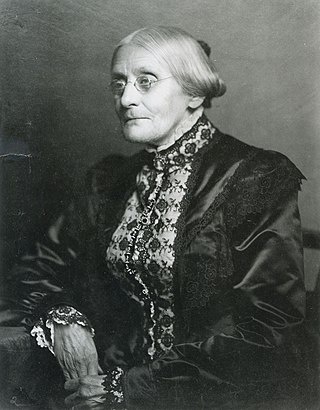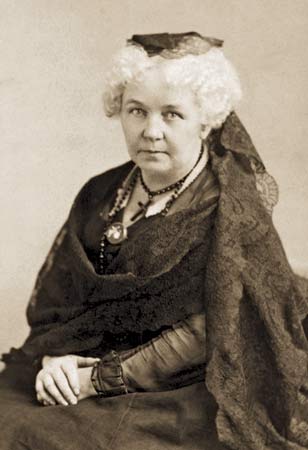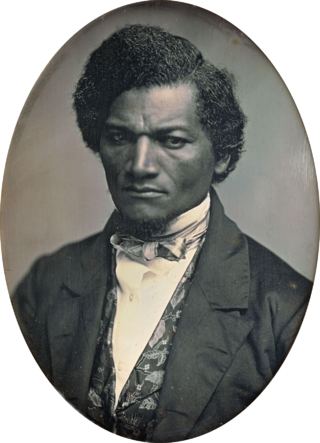
Frederick Douglass was an American social reformer, abolitionist, orator, writer, and statesman. He became the most important leader of the movement for African-American civil rights in the 19th century.

Susan B. Anthony was an American social reformer and women's rights activist who played a pivotal role in the women's suffrage movement. Born into a Quaker family committed to social equality, she collected anti-slavery petitions at the age of 17. In 1856, she became the New York state agent for the American Anti-Slavery Society.

The Declaration of Sentiments, also known as the Declaration of Rights and Sentiments, is a document signed in 1848 by 68 women and 32 men—100 out of some 300 attendees at the first women's rights convention to be organized by women. Held in Seneca Falls, New York, the convention is now known as the Seneca Falls Convention. The principal author of the Declaration was Elizabeth Cady Stanton, who modeled it upon the United States Declaration of Independence. She was a key organizer of the convention along with Lucretia Coffin Mott, and Martha Coffin Wright.

Elizabeth Cady Stanton was an American writer and activist who was a leader of the women's rights movement in the U.S. during the mid- to late-19th century. She was the main force behind the 1848 Seneca Falls Convention, the first convention to be called for the sole purpose of discussing women's rights, and was the primary author of its Declaration of Sentiments. Her demand for women's right to vote generated a controversy at the convention but quickly became a central tenet of the women's movement. She was also active in other social reform activities, especially abolitionism.

The Seneca Falls Convention was the first women's rights convention. It advertised itself as "a convention to discuss the social, civil, and religious condition and rights of woman". Held in the Wesleyan Chapel of the town of Seneca Falls, New York, it spanned two days over July 19–20, 1848. Attracting widespread attention, it was soon followed by other women's rights conventions, including the Rochester Women's Rights Convention in Rochester, New York, two weeks later. In 1850 the first in a series of annual National Women's Rights Conventions met in Worcester, Massachusetts.

The American Anti-Slavery Society was an abolitionist society founded by William Lloyd Garrison and Arthur Tappan. Frederick Douglass, an escaped slave, had become a prominent abolitionist and was a key leader of this society, who often spoke at its meetings. William Wells Brown, also a freedman, also often spoke at meetings. By 1838, the society had 1,350 local chapters with around 250,000 members.

The Liberator (1831–1865) was a weekly abolitionist newspaper, printed and published in Boston by William Lloyd Garrison and, through 1839, by Isaac Knapp. Religious rather than political, it appealed to the moral conscience of its readers, urging them to demand immediate freeing of the slaves ("immediatism"). It also promoted women's rights, an issue that split the American abolitionist movement. Despite its modest circulation of 3,000, it had prominent and influential readers, including all the abolitionist leaders, among them Frederick Douglass, Beriah Green, Arthur and Lewis Tappan, and Alfred Niger. It frequently printed or reprinted letters, reports, sermons, and news stories relating to American slavery, becoming a sort of community bulletin board for the new abolitionist movement that Garrison helped foster.

Women's suffrage, or the right of women to vote, was established in the United States over the course of the late 19th and early 20th centuries, first in various states and localities, then nationally in 1920 with the ratification of the 19th Amendment to the United States Constitution.

George Bradburn was an American politician and Unitarian minister in Massachusetts known for his support for abolitionism and women's rights. He attended the 1840 conference on Anti-Slavery in London where he made a stand against the exclusion of female delegates. In 1843 he was with Frederick Douglass on a lecture tour in Indiana when they were attacked. Lydia Maria Child wrote with regard to his work on anti-slavery that he had " a high place among the tried and true."
The Liberty Party was an abolitionist political party in the United States prior to the American Civil War. The party experienced its greatest activity during the 1840s, while remnants persisted as late as 1860. It supported James G. Birney in the presidential elections of 1840 and 1844. Others who attained prominence as leaders of the Liberty Party included Gerrit Smith, Salmon P. Chase, Henry Highland Garnet, Henry Bibb, and William Goodell. They attempted to work within the federal system created by the United States Constitution to diminish the political influence of the Slave Power and advance the cause of universal emancipation and an integrated, egalitarian society.

Women's suffrage was first granted in Utah in 1870, in the pre-federal period, decades before statehood. Among all U.S. states, only Wyoming granted suffrage to women earlier than Utah. Because Utah held two elections before Wyoming, Utah women were the first women to cast ballots in the United States after the start of the suffrage movement. However, in 1887 the Edmunds–Tucker Act was passed by Congress in an effort to curtail Mormon influence in the territorial government, disallowing the enfranchisement of the women residents within Utah Territory. Women regained the vote upon Utah statehood in 1896, when lawmakers included the right in the state constitution.
The National Women's Rights Convention was an annual series of meetings that increased the visibility of the early women's rights movement in the United States. First held in 1850 in Worcester, Massachusetts, the National Women's Rights Convention combined both female and male leadership and attracted a wide base of support including temperance advocates and abolitionists. Speeches were given on the subjects of equal wages, expanded education and career opportunities, women's property rights, marriage reform, and temperance. Chief among the concerns discussed at the convention was the passage of laws that would give women the right to vote.
Stephen Symonds Foster was a radical American abolitionist known for his dramatic and aggressive style of public speaking, and for his stance against those in the church who failed to fight slavery. His marriage to Abby Kelley brought his energetic activism to bear on women's rights. He spoke out for temperance, and agitated against any government, including his own, that would condone slavery.

Helen Bright Clark (1840–1927) was a British women's rights activist and suffragist. The daughter of a radical Member of Parliament, Clark was a prominent speaker for women's voting rights and at times a political realist who served as a mainstay of the 19th century suffrage movement in South West England. A liberal in all senses, Clark aided progress toward universal human brotherhood through her activities in organisations which assisted former slaves and aboriginal peoples.

Lucretia Mott was an American Quaker, abolitionist, women's rights activist, and social reformer. She had formed the idea of reforming the position of women in society when she was amongst the women excluded from the World Anti-Slavery Convention held in London in 1840. In 1848, she was invited by Jane Hunt to a meeting that led to the first public gathering about women's rights, the Seneca Falls Convention, during which the Declaration of Sentiments was written.

The American Equal Rights Association (AERA) was formed in 1866 in the United States. According to its constitution, its purpose was "to secure Equal Rights to all American citizens, especially the right of suffrage, irrespective of race, color or sex." Some of the more prominent reform activists of that time were members, including women and men, blacks and whites.
This timeline highlights milestones in women's suffrage in the United States, particularly the right of women to vote in elections at federal and state levels.

"What to the Slave Is the Fourth of July?" was a speech delivered by Frederick Douglass on July 5, 1852, at Corinthian Hall in Rochester, New York, at a meeting organized by the Rochester Ladies' Anti-Slavery Society. In the address, Douglass states that positive statements about perceived American values, such as liberty, citizenship, and freedom, were an offense to the enslaved population of the United States because they lacked those rights. Douglass referred not only to the captivity of enslaved people, but to the merciless exploitation and the cruelty and torture that slaves were subjected to in the United States.

United States v. Susan B. Anthony was the criminal trial of Susan B. Anthony in a U.S. federal court in 1873. The defendant was a leader of the women's suffrage movement who was arrested for voting in Rochester, New York in the 1872 elections in violation of state laws that allowed only men to vote. Anthony argued that she had the right to vote because of the recently adopted Fourteenth Amendment to the U.S. Constitution, part of which reads, "No State shall make or enforce any law which shall abridge the privileges or immunities of citizens of the United States."














